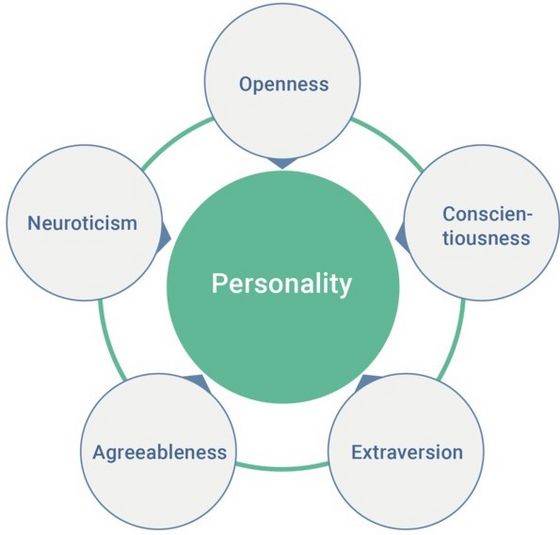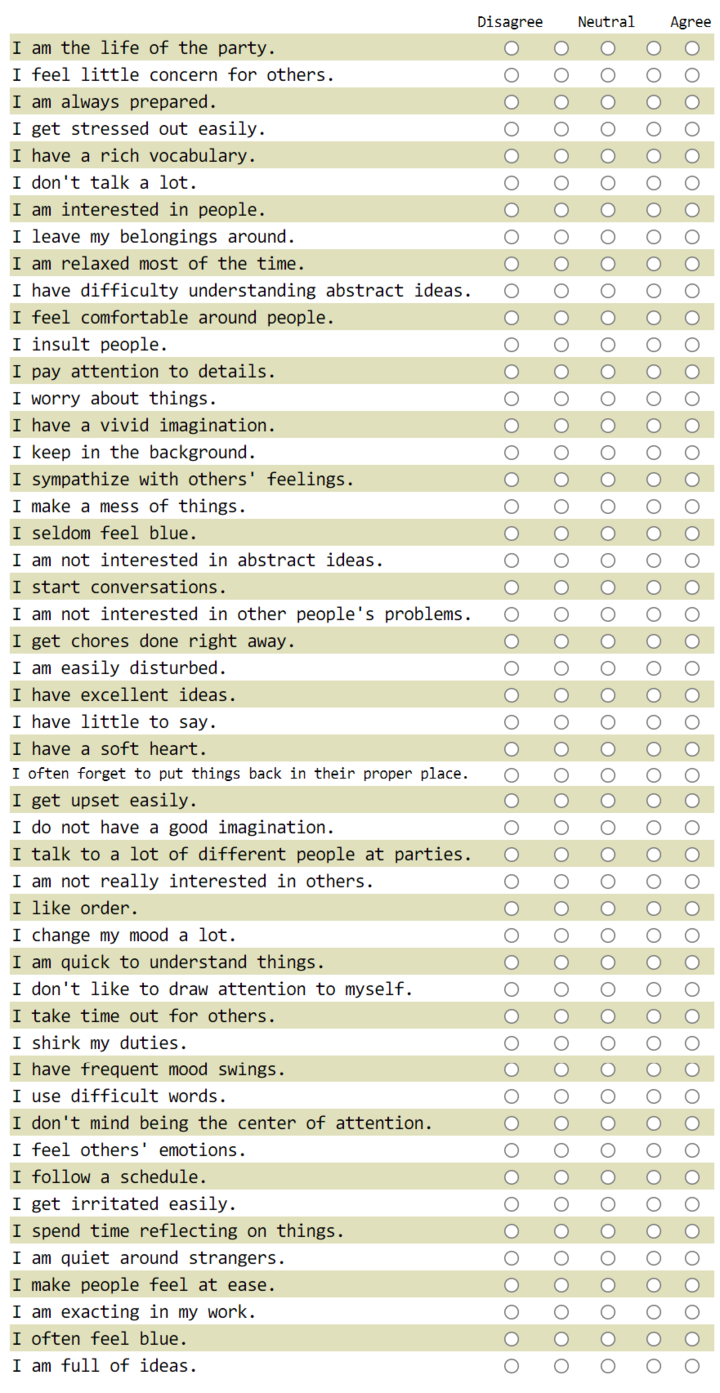The Big Five(OCEAN) Personality Traits
Qifan Wang (Talk | contribs) (→Application) |
Qifan Wang (Talk | contribs) (→Application) |
||
| Line 30: | Line 30: | ||
Nevertheless, the big five (OCEAN) personality traits are applied in academia far and wide. Researchers apply the OCEAN model in different fields and attempt to find out the relationship between personality and behavior. | Nevertheless, the big five (OCEAN) personality traits are applied in academia far and wide. Researchers apply the OCEAN model in different fields and attempt to find out the relationship between personality and behavior. | ||
| − | == | + | == Applicatio |
| − | + | ||
[[File:questionnaire.png|720px|thumb|right|Figure 2: Questionnaire of personality test.]] | [[File:questionnaire.png|720px|thumb|right|Figure 2: Questionnaire of personality test.]] | ||
Revision as of 18:18, 28 February 2022
Contents |
Abstract
Projects are done by people and for people.[1] Good project management is about how to organize people efficiently involving positions and tasks assigning, ways of communication, meeting people's satisfaction, etc.
Personality traits play an important role in people management, which have a big influence on success, efficiency, satisfaction, risk attitudes, performance, and more of projects. Since in a project, people have different backgrounds, interests, and personalities that make people think and manage the tasks in a different way and increase risks of conflicts somehow. A good perception of employees’ personality traits is a key for project managers to organize and design their teams. The similar and complementary personality traits make people, from different backgrounds and interests, well connected in a project and highly affect how and what they do in a project. Similarly, the action and decisions that project managers made are impacted by personality traits, which are not related to the technical part. It also influences how project managers deal with the relationship of different stakeholders.[1]
The so-called big five (OCEAN) personality traits theory is considered the dominant approach for representing the human trait structure today. Researchers have used the theory to predict individual differences in numerous settings: clinical (reviewed in Costa, 1991), industrial and organizational (e.g., Barrick & Mount, 1991, 1996; Barry & Stewart, 1997; Mount & Barrick, 1995), counseling (McCrae & Costa, 1991), and more [2].It was founded by Fiske (1949) and later expanded and elaborated by Norman (1967), Smith (1967), Goldberg (1981), and McCrae and Costa (1987). This theory contains five basic factors that are Openness, Conscientiousness, Extraversion, Agreeableness, Neuroticism[3].
The Big Idea
What is the big five(OCEAN)
The big five(OCEAN) theory has developed, widespread, and ascended to the dominant status of the personality researching field in the last 20 years[4]. Apparently, the acronym OCEAN, the capital five letters, come from five basically general-accepted perspectives of personality traits are Openness, Conscientiousness, Extraversion, Agreeableness, and Neuroticism.
Openness(O): It is also named as openness of experience. Individuals who score high on this dimension tend to be intellectual, imaginative, sensitive, and open-minded. Those who score low tend to be down-to-earth, insensitive, and conventional[2]. Research has shown that openness to experience is an important component of leadership effectiveness and seems particularly important at higher organizational levels. Leaders with higher openness to experience scores take a more strategic approach to solving problems, this can help those in higher leadership or management positions keep abreast of market trends, competitive threats, new products, and regulatory changes[5].
Conscientiousness(C): Individuals high in Conscientiousness tend to be careful, thorough, responsible, organized, and scrupulous. Those low on this dimension tend to be irresponsible, disorganized, and unscrupulous[2]. Conscientiousness is an aspect of ego and strength over time and is often associated with terms such as willpower, initiative, and responsibility[3].
Extraversion(E): Individuals who score high on Extraversion tend to be sociable, talkative, assertive, and active; while those who score low are more reserved in nature, but does not mean that they are socially hostile, instead are retiring, reserved, and cautious. Moreover, the active and assertive aspects of Extraversion facilitate the goal of achievement values, success through demonstrating competence according to social standards[2]. Leaders high in extraversion come across as self-confident, outspoken, opinionated, and competitive[3].
Agreeableness(A): Individuals who score high on Agreeableness tend to be soft-hearted, kind, good-natured, trustworthy, helpful, forgiving, and altruistic[3]. Individuals who score low on this dimension tend to be irritable, ruthless, suspicious, and inflexible[2]. Agreeableness, is primarily a dimension of interpersonal behaviors, whereas extraversion is more related to the preferred quantity of social excitability. Agreeableness represents more on the quality characteristics of the interaction. This dimension is most familiar in its role as one of the defining axes of interpersonal behavior. Agreeableness also influences the self-image of an individual and helps shape social attitudes and the principles of life itself[3].
Neuroticism(N): Neuroticism refers to the chronic level of how an individual adjusts their emotions and instability. Individuals who score high in neuroticism tend to be identified as those who are vulnerable to psychological distress. This includes a high pessimistic way of thinking, such as anger, hostility, depressiveness, anxiety, and volatility. However, neuroticism also involves the vulnerability of an individual towards stress, self-consciousness, extreme desire, urges, and the difficulty to handle frustration caused by not acting based on their will[3]. Differences in neuroticism can be somewhat difficult to observe in predictable, routine situations but become readily apparent during times of uncertainty or crisis. leaders who are calm under pressure and thick-skinned can often help a group stay on task and work through any difficult issues[5].
Who need it?
The big five (OCEAN) personality traits theory, regarding as a tool, are usually used in the human resources(HR) department of a company, especially for employers, project managers, and recruiters. Meanwhile, it can be also used by employees in the work environment [6].
For the HR department, a good employee is a key to success for projects. The project managers or recruiters can make full use of the OCEAN model to identify people whether they suit the position and the company culture or not. This is crucial in project management.
For employees, the big five(OCEAN) personality traits theory can boost employees’ career prospects or help them find a new role in the company. This could happen before or after employees get offers. In a word, this tool can definitely instruct people in their careers.
Nevertheless, the big five (OCEAN) personality traits are applied in academia far and wide. Researchers apply the OCEAN model in different fields and attempt to find out the relationship between personality and behavior.
== Applicatio
Limitations
Annotated bibliography
- ↑ 1.0 1.1 Geraldi, Joana et al. How to DO Projects : A Nordic Flavour to Managing Projects. Dansk Standard, 2017, pp. 160 s.
- ↑ 2.0 2.1 2.2 2.3 2.4 Roccas, Sonia, et al. “The Big Five Personality Factors and Personal Values.” Personality and Social Psychology Bulletin, vol. 28, no. 6, Sage Publications, 2002, pp. 789–801, doi:10.1177/0146167202289008.
- ↑ 3.0 3.1 3.2 3.3 3.4 3.5 Lee, Chia Kuang, and Mei Yit Foo. “Risk Attitudes and the Big Five Personality Traits: a Study on Construction Project Practitioners in Malaysia.” International Journal of Construction Management, Taylor and Francis Ltd., 2020, pp. 1–11, doi:10.1080/15623599.2020.1793506.
- ↑ M. Hastings, Brad, and Mount Aloysius College. ROY G. BIV and the OCEAN A Heuristic Metaphor for Understanding the Role of the Five-Factor Model in Personality Research. 2016.
- ↑ 5.0 5.1 NIGEL CHETTY (MBA). The OCEAN Model of Personality[1]
- ↑ Anastasia Belyh. The Big Five Personality Traits Model (OCEAN Model)[2]

